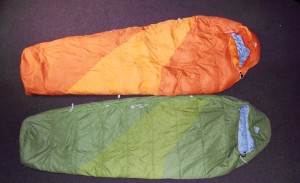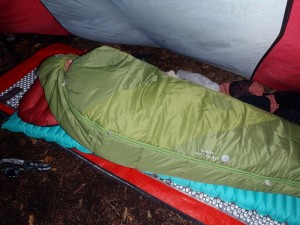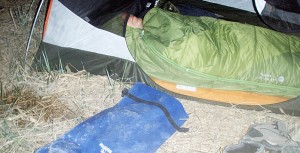
One area where the “ultralight” mantra has hurt gear design is in summer sleeping bags with hoods. Remove the hood, and you can save a few ounces, but keep the hood, and you can stretch the temperature range of the bag by 10 degrees, 20 degrees, or more. Some of our favorite bags over the years have been rated in the 30-40 degree range; open the hood, and suddenly you’ve got a bag that’s comfortable at 50-60 degrees, but will still keep you warm when radiational cooling suddenly creates a frost in that little pocket you settled into for the night.
Kudos, then, to Kelty for bucking the trend with the Ignite 40. EN rated to 37 degrees, it’s a moderately priced ($110) synthetic in the same series as the beloved Ignite DriDown 0, which is arguably the overall best 0 rated bag we’ve ever used. In particular, the proportions seemed to work for virtually everyone, and the hood snugged down perfectly around more heads than any hood we’ve used. Our first thought: If the Ignite 40 lived up to that standard, it’d be a dream. At 2 lbs, 1.5 oz. (actual weight of our sample), weight is very reasonable for the price, and the ECOPET recycled insulation drapes well and packs down to a reasonable size. Sounds great so far, but we’ve been fooled before, getting out into the field and being disappointed (particularly by synthetic insulations, which vary radically in how well they handle moisture transfer). Test time.

The Kelty happened to arrive in the late fall, just when “shoulder season” bags would be the ideal choice. But, intrepid testers took it out, anyway. And yet again, we found an EN13537 rating to be inaccurate. Luckily, this time around it turned out that the bag OUTperformed its specs, not underperformed. Multiple times, testers used the bag when the mercury flirted with the 32 degree mark, and slept warm and comfortable (as always, with a fresh baselayer on and a good mattress pad underneath).
Perhaps the toughest test came this spring on a kayaking trip; the forecast predicted 37 degrees overnight, perfect for the Ignite’s EN rating. Yeah, well…by 4 a.m., our test dummy was on the edge of cold and cursing the weatherman. When we found ice in our canteens INSIDE the tents, it was clear that radiational cooling had done its work, and that we were well down into the 20s. The tester’s final word: “For the last couple of hours, I was almost at the point where it would have been worth putting on another layer, but not quite. But, I certainly snugged the hood down all the way!” At 10 degrees below rating, that’s impressive. Clearly, the ECOPET insulation moves moisture away from the body well; we’ve come to believe that one of the problems with EN13537 (among several) is that it can’t take into account conductive losses created by poor moisture transport (our evaluation of DriDown helped clarify that in our minds).

And, the hood? Well, it’s not the same as the DriDown 0…we even compared the panels to see how it was cut, and it’s definitely simpler. But, it’s still very functional. All our testers were all able to get it snugged to a breathing hole in the right position, and there was plenty of room to wear a hat; in fact, if there was any complaint, it was that it was TOO big. Better that than the other way!
For many backpackers, the Ignite 40 could be the only bag they need; put on a couple of pairs of socks, wear your pants and hat, and you can probably be comfortable down close to 20 degrees (assuming you use a good mattress pad; we tested with the excellent Kelty Recluse 2.5i). Unless you push the limits of shoulder season, you’re likely to be able to stay comfortable in most conditions you’ll encounter (as long as you follow the sleeping warm guidelines). Maybe this signals the return of hooded summer bags; we can only hope!


